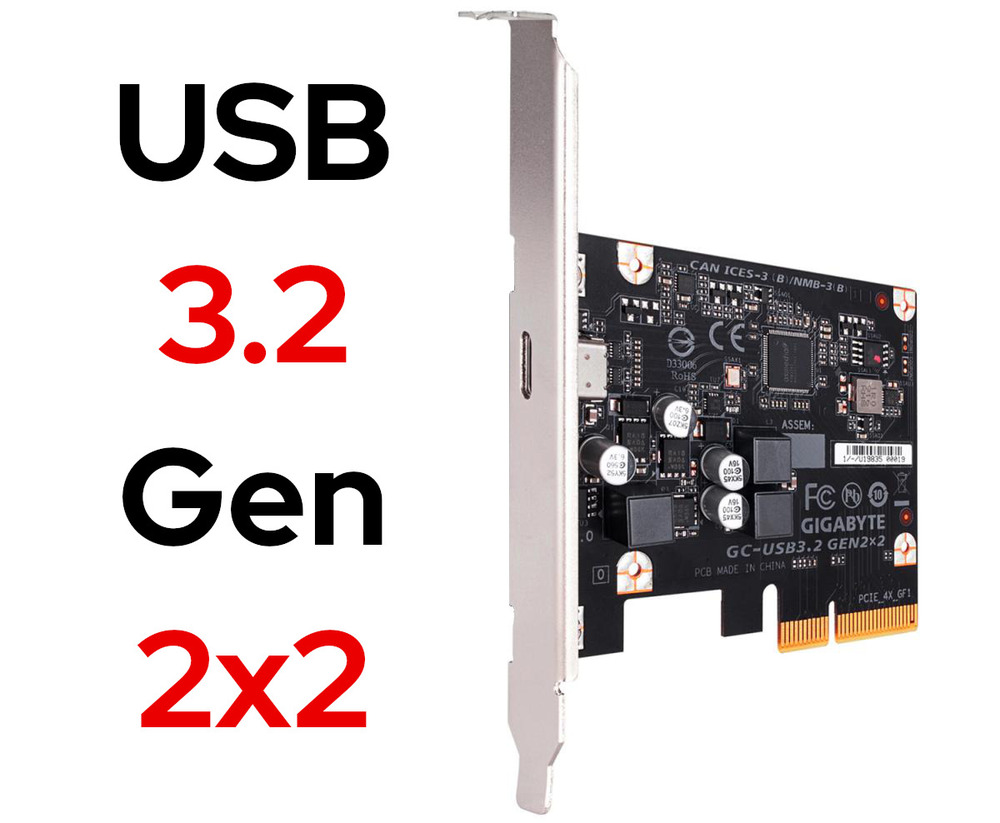USB 3.2 Gen 2x2
USB V3.2 is here! What does it mean! The USB Implementers Forum (USB-IF) has been busy this year. Earlier they released an update governing USB power delivery and defining power levels up to 100W. More recently, they published USB specification version 3.2 and introduced a new data transfer rate of 20Gbps. The industry has been waiting for this ever since the USB-IF first announced it clear back in 2017.
Similar to what happened when the USB 3.1 specification was introduced, the newer specification supplants the older ones and redefines the naming conventions of all of the data transfer speeds. The result of this is that the USB landscape, which was already murky, has gotten even more confusing.
The following table illustrates how the data transfer speed naming conventions have been modified with each update to the USB 3.x Specification:
| Transfer Speed | First Introduced | Name in USB 3.0 Specification | Name in USB 3.1 Specification | Name in USB 3.2 Specification | Also Known As |
|---|---|---|---|---|---|
| 5Gbps | USB 3.0 Specification | USB 3.0 | USB 3.1 Gen 1 | USB 3.2 Gen 1 | SuperSpeed 5Gbps |
| 10Gbps | USB 3.1 Specification | Not Applicable | USB 3.1 Gen 2 | USB 3.2 Gen 2 | SuperSpeed 10Gbps |
| 20Gbps | USB 3.2 Specification | Not Applicable | Not Applicable | USB 3.2 2x2 | SuperSpeed 20Gbps |
Notice that the latest data speed, 20Gbps, is not dubbed USB 3.2 Gen 3 as one would expect. Confusing, right? Well, this is because the 20Gbps transfer speed is actually achieved by using two 10Gbps lanes. All of the other transfer speeds use only one lane. If the new transfer speed had only required one lane, the expected Gen 3 tag would have been used. The USB-IF settled on the 2x2 moniker to highlight the fact that multiple lanes are needed.
Furthermore, and most importantly, the new spec only addresses the data transfer speeds, not the connector types or power delivery levels. This means that older connector types, such as USB Type-A, USB-mini, and USB-micro, can all be labeled as USB 3.2 compliant and not support the 20Gbps transfer speed. In fact, only USB-C connectors can handle multi-lane transfers and higher power-delivery levels.
The following table shows the correlation of power delivery to USB-IF specifications and which one each USB connector type supports.
| Power Delivery | Defined In | Type-A | Mini | Micro | Type-C |
|---|---|---|---|---|---|
| 2.5W (5V at 500mA) | USB V2.0 Specification | Yes | Yes | Yes | Yes |
| 4.5W (5V at 900mA) | USB V3.0 Specification | Yes | Yes | Yes | Yes |
| 7.5W (5V at 1.5A), 15W (5V at 3A) | USB V3.1 Specification | Yes | Yes | Yes | Yes |
| Up to 100W (5V at 20A) | USB Power Delivery Specification Revision 3.0 Release 2.0 | No | No | No | Yes |
To mitigate the confusion, the USB-IF is asking all vendors to clearly list their device’s actual capabilities. In addition to this, they ask that vendors strictly use the naming conventions above and stop using names like “Hi-Speed USB”, “SuperSpeed+”, “SuperSpeed Plus”, and “Enhanced SuperSpeed.” All of these names are ones that were defined in the older USB specifications.
Even if vendors follow these guidelines, it will take some time before the fog over these changes clears. There are many vendors out there, and they are not going to recall their existing products just so that they can ‘rebadge’ them. The result is that the older cabling and device names will continue until the current inventory is used up. What this really means, though, is that the onus will be on the consumer to verify that they are getting what they expect.
The biggest concern by far is that the multi-lane 20Gbps transfer rate is not solely governed by the cable being used. USB-C cables should already support 20Gbps speeds because they were designed to be able to support multi-lane transfers from the start. However, the hardware to which the USB-C cable is connected is a very different story.
The vast majority of USB controllers in existing hardware do not support multi-lane transfers. To make matters worse, existing hardware cannot be upgraded via a patch or driver change. To achieve the highest transfer speeds, this hardware will have to be replaced. A web search for USB 3.2 2x2 will show that this support is available only in some new add-in cards. There are a couple of motherboards out there that say they support USB 3.2, but digging deeper shows that support is limited to USB 3.2 Gen 2.
When it comes to portable computers, tablets, cell phones, and most other USB devices, slapping in a newfangled card is not an option. For each of these, the physical hardware itself needs to be replaced with newer hardware containing embedded USB controllers that have multi-lane support. This probably means having to buy an entirely new device.
So, if you want the fastest USB data transfer rates (and power levels), there’s good news and bad news for you …
The good news: Your existing USB-C cables are probably good to go.
The bad news: Your hardware probably is not and will need to be replaced.
Oh, and the USB-IF has announced USB 4.0 coming soon.
Consider yourself warned!
